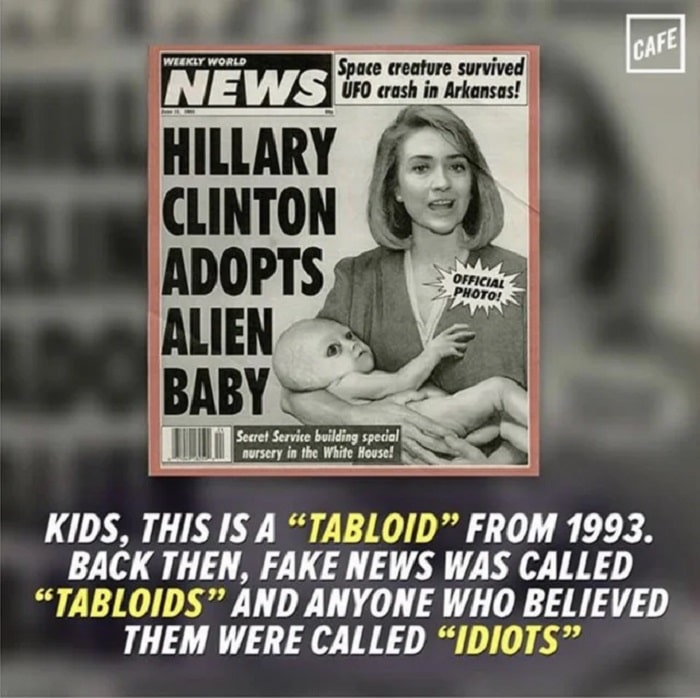
History of Fake News
In 1993, The Weekly World News printed an edition with the sensational headline: HILLARY CLINTON ADOPTS ALIEN BABY, replete with a photo of mother and child. This and other cringe-worthy headlines were standard fare at the time, and readers couldn’t get enough of them.
Back then, such obviously fraudulent information was known by most to be a hoax, and the publications that ran them were called tabloids. The most famous of these was The National Enquirer—a paragon of misinformation in the pre-internet age—and a haven for the gullible. But sales were through the roof, proving that fake news has always been popular, even entertaining, and most people read tabloids solely for the amusement factor.
Things are different today. The world is a chaotic and complicated place, where just keeping up with local events can be difficult; while wading through the clutter of real news, fake news, propaganda, hyperbole, twisted ideologies and outright lies that bombard us every day can be daunting and confusing. Tabloids still exist today, but many of them are disguised as real news.
Media manipulation in the form of clickbait, pseudo-news, controversy, misleading headlines, satire, half-truths, alt-right opinion, even “Truthiness” abound, not only on the internet but also in print and televised media.
So how can you tell what’s real?
Twenty-four-hour news cycles have made the world a smaller place. Knowing what’s going on, whether close to home or far away, is important because it affects us all. Don’t listen to a particular news source simply because you agree with their spin on things. Listen to and read a variety of news sources, not just those that appeal to you. For example, if you like conservative news and you listen exclusively to Fox and Friends, you’re only getting one point of view, which may be biased, unbalanced, and designed to appeal to an unsophisticated audience.
In order to get all the facts about a story or issue, balance your Fox News viewing with a more mainstream and objective source of news such as Bloomberg, NPR, PBS, MSNBC, etc. Sure, they all have an agenda, sometimes minor, sometimes extreme, but the truth always lies somewhere in the middle and never at either end of the information spectrum.
Be Smart About It
Keep in mind that all American news outlets are owned by only six conglomerates that control everything we see and hear. They, not you, decide which news they think you need to know. Some of them are shills for major corporations, political parties, corrupt billionaires, and rogue politicians. They may be spewing personal opinion, trying to scare you with half-truths, outright lying to you, or trying to persuade you to their way of thinking by providing fraudulent evidence for their claims.
Talking heads and blithering pundits who spew their personal commentary and controversial opinions are not sources of news. They are merely entertainers, deceiving millions of people every day. Above all, never rely on social media sites like Facebook and YouTube to deliver real news.
We, as conscientious news consumers, need to exercise vigilance and objectivity if we really want to know what’s going on, not only in our own country but also in the increasingly crazy, newsy, tabloid world in which we live.
By using the following tips, you can assess the reliability of the sources you rely on for news. After putting your current news source to the test, you may even change your mind about who you trust to tell you the truth.
- Consider the source. Many fake news sites have emerged in the past three years. Bogus headlines, “fantasy news” and satire are meant to entice readers but don’t provide any clue as to who they are, what their mission is, or where they are located. Trustworthy news outlets usually include an “About/About Us” section with contact and background information.
- Check the web domain. Many bogus stories will reference official-sounding sources, cite familiar names, or use legitimate-looking URLs to deceive careless readers. Beware of URLs that look odd or end with “.com.co” or “.lo”. Does the site look amateurish or include annoying ads? Does it have lots of spelling and punctuation errors, use bad grammar, or yell in ALL CAPS?
- Read past the headlines. Shocking headlines can fool gullible readers into believing something that may have little relevance to the story that follows. Read the whole story, not just the headline. Avoid mendacious claims and online rumors. If a story tries to assure you that “THIS IS NOT A HOAX!!!”, rest assured that it is.
- Who’s the author? Was the story written by a reputable expert or trusted author? Do they work for a professional news organization? Beware of stories that have no byline or try to push an obvious agenda. Fake news articles often don’t include author names. If they do, Google search the author’s name to see if he or she is legitimate.
- What’s the central message? Read the article carefully and be your own editor. Bogus news articles often push a singular biased viewpoint or present angry, inflammatory or distorted “facts.” Does the article seem fair, balanced and objective? If not, someone may be trying to deceive you.
- Check the date. Some false stories may actually contain factual information, but may include claims that are no longer relevant. Although a recent story may have a connection to the past, real news should be timely and applicable to current events.
- Don’t be a sucker. Satire is a wonderful form of comedy escapism, and some satirical sites like The Onion are extremely good at it, but not all satirical sites are clearly identified. It’s easy to swallow this “clickbait” and pass it along to others who may also think it’s real. Don’t take the bait!
- Consider your biases. We all have something called “confirmation bias” which causes us to give greater credibility to information that conforms to our beliefs. The Facebook post that made you angry may have no factual basis. Anyone can make a meme or write a rant. Social media is not a credible source for news.
- Consult an expert. Debunking takes time, but there’s a good chance that someone has already done the fact-checking for you. FactCheck.org, Snopes.com, the Washington Post Fact Checker and PolitiFact.com are respected sources for verifying news stories or proving them fraudulent. What do the fact-checkers say?
- Think critically. Analyze sources and quotes. Be skeptical. Does the article include and identify reliable sources? Fake news articles are notorious for citing anonymous or questionable sources or no sources at all. Look for other articles on the same topic. If a story can’t be corroborated, there’s a good chance it’s fake.






